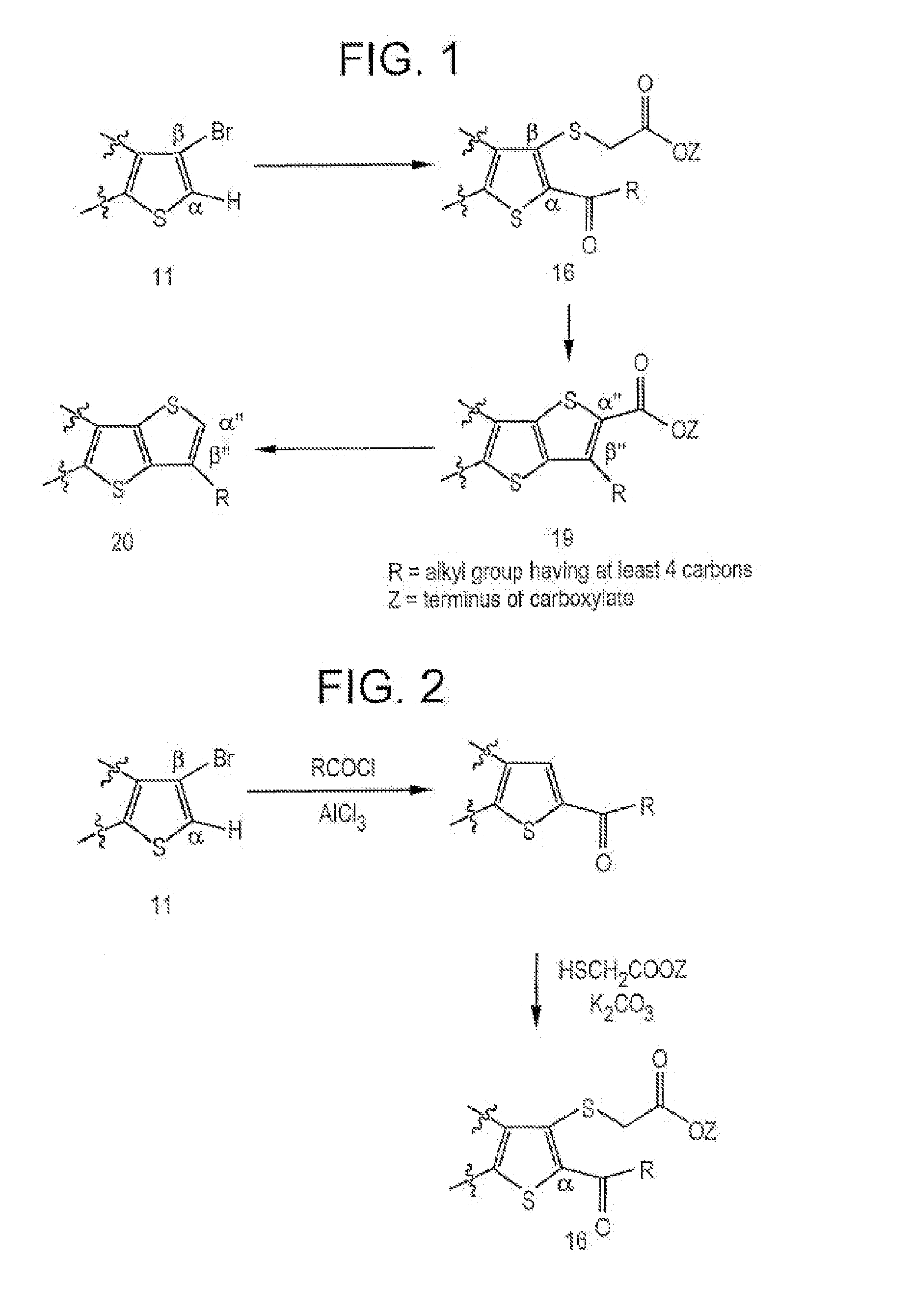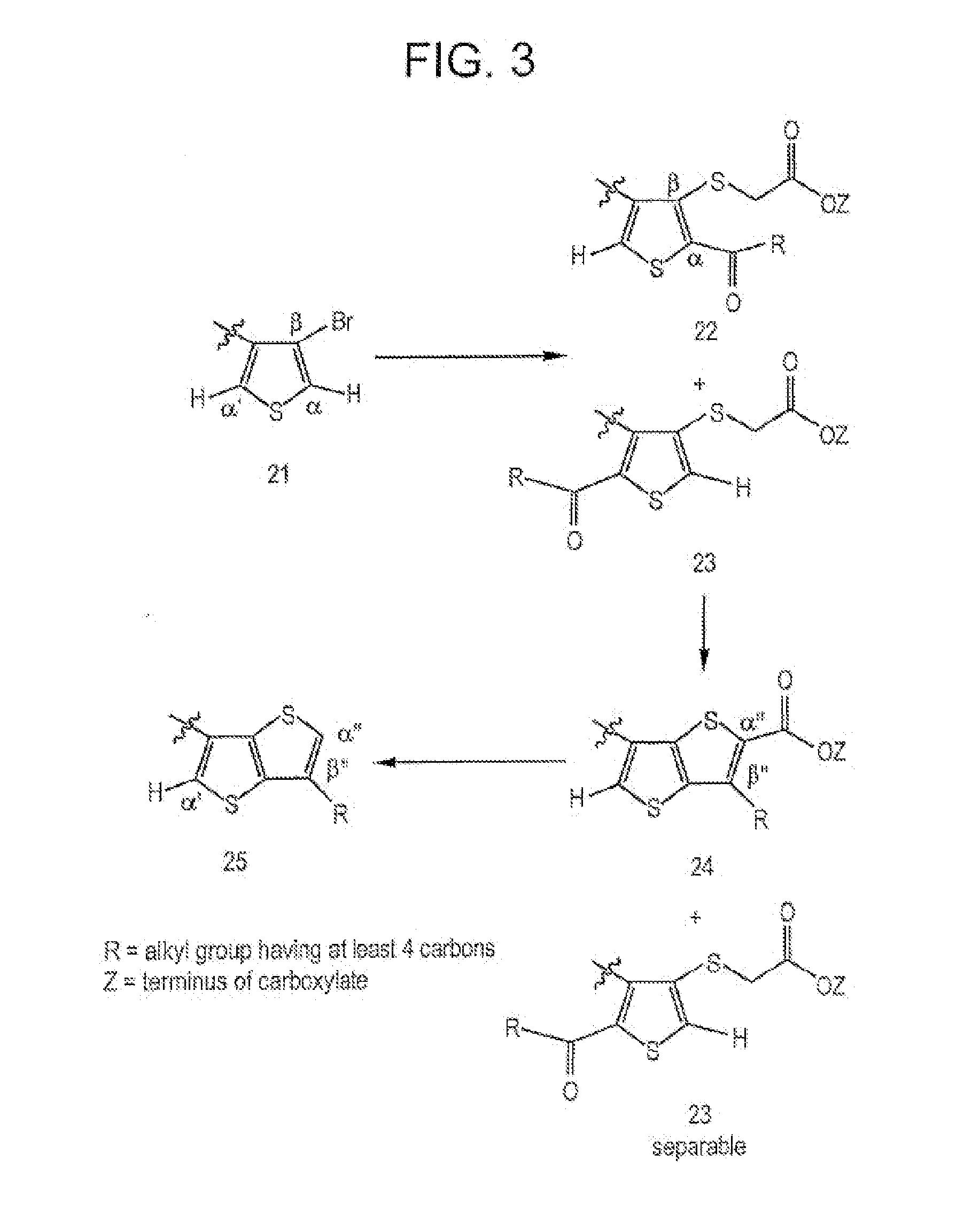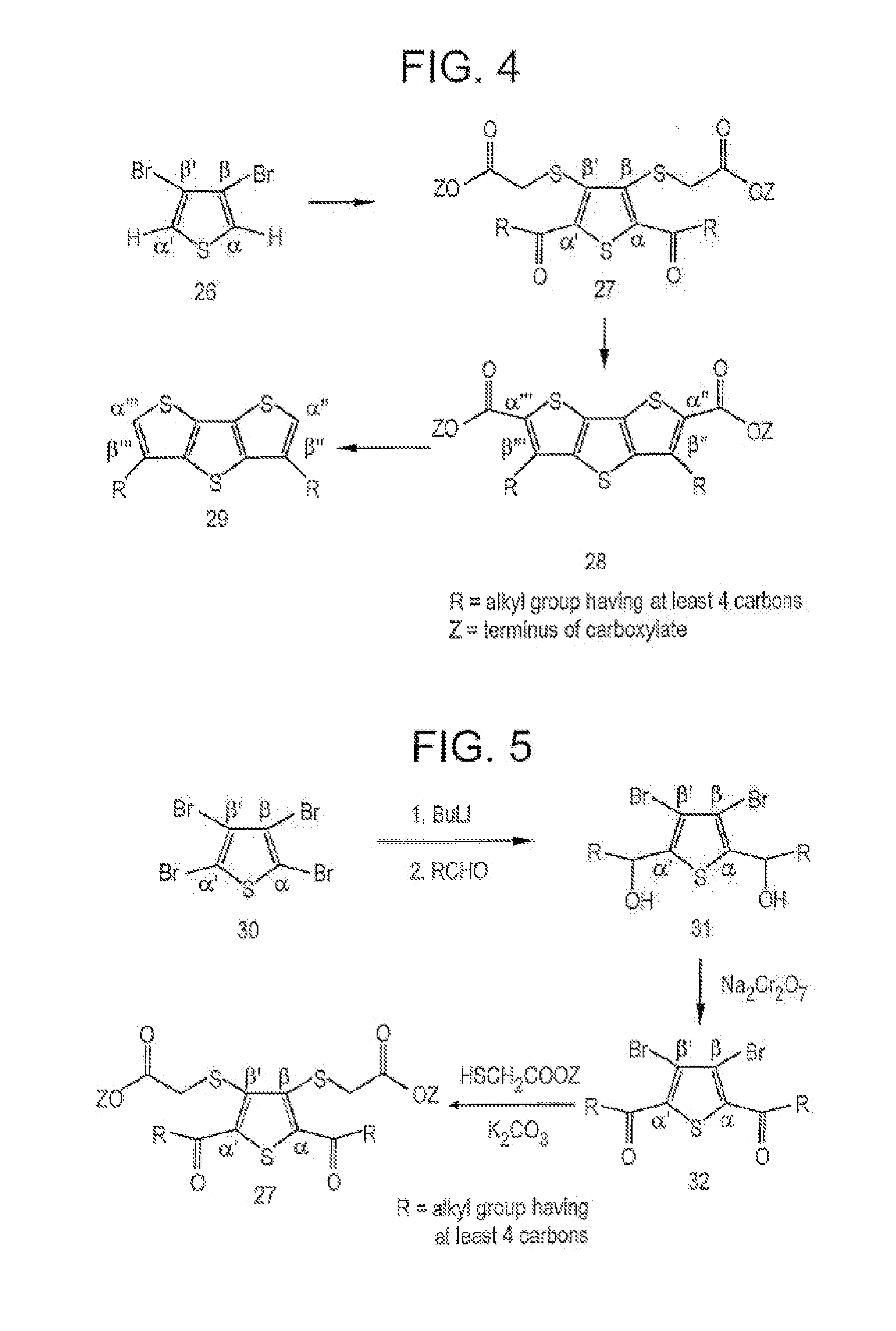Fused thiophenes, methods of making fused thiophenes, and uses thereof
a technology of fused thiophene and thiophene, which is applied in the field of fused thiophene compounds, can solve the problems of marginal processability, low solubility of unsubstituted fused thiophene-based materials, and oxidative instability, and achieve the effect of improving the oxidative stability of compositions
- Summary
- Abstract
- Description
- Claims
- Application Information
AI Technical Summary
Benefits of technology
Problems solved by technology
Method used
Image
Examples
example 1
Di-β-substituted thieno[3,2-b]thiophenes
[0107]3,6-dihexylthieno[3,2-b]thiophene 57 is synthesized as shown in the reaction scheme of FIG. 10.
2,4,5-Tribromo-3-hexylthiophene (51)
[0108]3-Hexylthiophene (50) (100 g, 0.595 mol) is mixed with 200 mL acetic acid. To this mixture, bromine (88 mL, 1.33 mol) is added dropwise. After addition of the bromine, the resulting mixture is stirred at room temperature for 4 hours, heated to 60-70° C. overnight, then poured into 800 mL ice water and neutralized with 6M aqueous NaOH. The mixture is extracted with ethyl acetate (3×100 mL). The combined organic layers are washed with brine (2×100 mL) and water (100 mL) and dried over MgSO4. Evaporation of the solvent yielded crude 51 (234 g, 97.1% crude yield). The crude product is sufficiently pure for use in subsequent reactions. 1H NMR (CD2Cl2): δ 2.64 (t, 2H), 1.51 (m, 2H), 1.32 (m, 6H), 0.89 (t, 3H). 13C NMR: 143.69, 117.86, 111.48, 110.18, 33.62, 32.86, 30.96, 30.52, 24.70, 16.00.
3-Bromo-4-hexylthi...
example 2
Mono-β-substituted thieno[3,2-b]thiophenes
[0114]3-Hexylthieno[3,2-b]thiophene 58 is synthesized as shown in the reaction scheme of FIG. 11.
1-(3-Bromothienyl)heptanone (59)
[0115]Heptanoyl chloride (14.9 g, 0.1 mol) is added dropwise at room temperature to a mixture of 3-bromothiophene (60) (16.3 g, 0.1 mol), AlCl3 (26.8 g, 0.2 mol) and CH2Cl2 (100 mL). The resulting mixture is stirred for approximately two hours, or until which time GC / MS analysis indicates complete conversion of compound 60 to compound 59. The reaction mixture is poured into cold HCl (aq) (6M, 200 mL). The organic component is extracted with hexane (3×100 mL). The combined organic layers are washed with brine (2×100 mL) and water (100 mL). After drying over MgSO4, the crude target compound is purified by column chromatography (SiO2 / hexanes) to yield compound 59 (25.1 g, 91.3% yield). GC / MS: 275 g / mol (M) 1H NMR (CD2Cl2): δ 7.53 (d, 1H), 7.12 (d, 1H), 3.01 (t, 2H), 1.71 (m, 2H), 1.38 (m, 6H), 0.92 (t, 3H).
Ethyl 3-hex...
example 3
di-β-substituted dithieno[3,2-b:2′-3′-d]thiophenes and di-β-substituted dithieno[3,2-b:2′-3′-d]thiophene-4,4-dioxides
[0119]3,6-didecylthieno[3,2-b]thiophene 63 and 3,6-didecylthieno[3,2-b]thiophene-4,4-dioxide 64 are synthesized as shown in the reaction scheme of FIG. 12.
1,1′-(3,4-Bromo-2,5-thienyl)diundecanol (65)
[0120]Butyllithium (160 mL, 0.4 mol, 2.5M in hexanes) is added dropwise at −78° C. to a solution of tetrabromothiophene 36 (80.0 g, 0.2 mol) and THF (500 mL). Undecylic aldehyde (DecCHO) (69.7 g, 0.41 mol) is added, and the reaction mixture is stirred for two hours. The THF solvent is then removed by evaporation, and the organic residue is extracted with hexanes. The combined organic layers are washed by brine (2×100 mL) and water (100 mL) and dried over MgSO4. The crude product is purified by column chromatography (SiO2 / 5% ethyl acetate in hexanes) to yield compound 65 (84.1 grams, 72.5% yield). 1H NMR (CD2Cl2): δ 5.02 (s, br, 2H), 1.79 (m 4H), 1.28 (m, 32H), 0.88 (t, 6H)...
PUM
| Property | Measurement | Unit |
|---|---|---|
| molecular weight | aaaaa | aaaaa |
| molecular weight | aaaaa | aaaaa |
| molecular weight | aaaaa | aaaaa |
Abstract
Description
Claims
Application Information
 Login to View More
Login to View More - R&D
- Intellectual Property
- Life Sciences
- Materials
- Tech Scout
- Unparalleled Data Quality
- Higher Quality Content
- 60% Fewer Hallucinations
Browse by: Latest US Patents, China's latest patents, Technical Efficacy Thesaurus, Application Domain, Technology Topic, Popular Technical Reports.
© 2025 PatSnap. All rights reserved.Legal|Privacy policy|Modern Slavery Act Transparency Statement|Sitemap|About US| Contact US: help@patsnap.com



